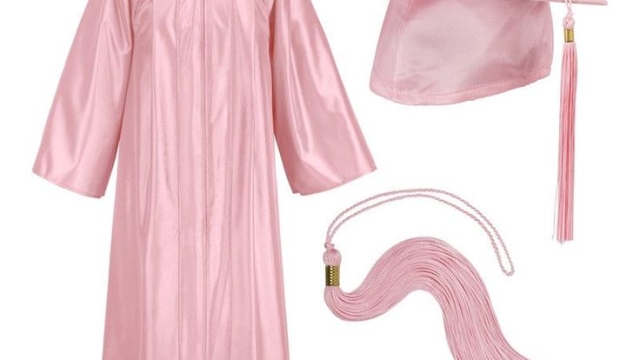Throughout history, graduation ceremonies have stood as pivotal moments of accomplishment and transition. These ceremonies, filled with rich traditions and symbolic gestures, are an opportunity for students to celebrate their hard work and the culmination of their educational journey. At the heart of every graduation ceremony is the iconic attire of graduation caps and gowns, which have a long and fascinating history of their own. From their origins in medieval Europe to their modern interpretations, these caps and gowns have become synonymous with academic achievement and signify the transition from student to graduate. Join us as we delve into the world of graduation attire, exploring its evolution and meaning, and providing a guide for today’s graduates in selecting the perfect cap and gown to wear on their special day.
The Evolution of Graduation Attire
In the annals of academia, graduation caps and gowns have become iconic symbols of achievement and scholarly tradition. These timeless garments have evolved over the centuries, mirroring the progress and transformation of education itself.
During medieval times, the origin of academic regalia can be traced back to the universities of Europe. It was customary for scholars to dress in long robes, usually made of black fabric, to protect against the cold and damp conditions of medieval classrooms. These early gowns were often trimmed with fur or velvet, indicating the wearer’s social status and wealth.
As universities expanded and educational institutions were established around the world, graduation attire began to take on a more standardized form. In the 14th century, the long-standing tradition of incorporating hoods into academic dress originated in England. These hoods were initially practical accessories, serving as a way to keep warm in cold lecture halls. However, they soon became ceremonial symbols, representing the wearer’s academic discipline and level of achievement.
The modern graduation cap, known as the mortarboard, first emerged in the late 19th century. Its distinctive square shape, flat top, and tassel have since become universally recognized symbols of graduation. The design was inspired by the biretta, a type of hat worn by Roman Catholic clergy. Gradually, the mortarboard became an integral part of graduation attire, worn by students to signify the completion of their academic journey.
As graduation caps and gowns continue to be worn with pride across educational institutions worldwide, their significance remains steadfast. These timeless symbols embody the perseverance and dedication of students who have successfully navigated the challenging path of higher education while honoring centuries of academic tradition.
Symbolism and Significance of Graduation Caps and Gowns
When it comes to graduation ceremonies, one can’t help but notice the prominent presence of caps and gowns. These traditional academic attire carry a deep symbolism and hold great significance for both the graduates and the educational institutions they represent.
A Visual Representation of Achievement
The graduation cap and gown serve as a visual representation of academic achievement. They signify the culmination of years of hard work and dedication, and the successful completion of an educational journey. These garments proudly showcase the accomplishments of the graduates and the recognition they have earned.Uniformity and Equality
Wearing identical caps and gowns creates a sense of uniformity and equality among the graduates. Regardless of background, race, or social status, everyone is dressed the same way, emphasizing the notion that academic accomplishments transcend individual differences. It reinforces the idea that, on this special day, all graduates are equal.Connection to Academic Tradition
The tradition of wearing caps and gowns dates back centuries, with origins rooted in medieval Europe. These garments connect today’s graduates to a long line of scholars who have celebrated their academic accomplishments in a similar manner. It fosters a sense of belonging and continuity with the rich history of academia.
In conclusion, the symbolism and significance of graduation caps and gowns extend beyond their visual appeal. They represent academic achievement, promote equality among graduates, and connect individuals to the timeless tradition of celebrating scholarly success.
Graduation Attire: Contemporary Trends and Variations
When it comes to contemporary trends and variations in graduation attire, there are a few key elements that have gained popularity in recent years. These modern updates bring a fresh look to the traditional graduation caps and gowns, allowing graduates to express their individuality and style on this special day.
Firstly, the use of vibrant colors has become increasingly prevalent in graduation attire. While the classic black remains a timeless choice, many graduates now have the option to don caps and gowns in a wide array of hues. This allows them to showcase their school spirit or personal preferences, making graduation ceremonies even more visually captivating.
Miami graduation apparel
In addition to colors, customized embellishments have become a popular way for graduates to add a unique touch to their attire. From intricate embroidery representing their achievements to personalized patches or pins showcasing their interests or clubs, these small details allow graduates to stand out and celebrate their accomplishments in a distinct and memorable way.
Lastly, alternative fabrics and modernized silhouettes have also entered the scene of graduation attire. Graduates now have options beyond the traditional polyester or satin gowns, with lighter and more breathable fabrics being introduced. Additionally, contemporary cuts and designs have emerged, offering more flattering and comfortable options that still maintain the elegance and formality expected of graduation ceremonies.
In conclusion, contemporary trends and variations in graduation attire have introduced a new level of individuality and style to the traditional caps and gowns. With vibrant colors, customized embellishments, and modern fabric choices, graduates are able to express themselves and celebrate their achievements in a way that is both unique and memorable.

